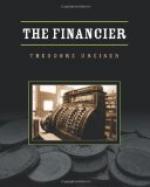It seemed to him now that his comparatively commonplace house could be made into something charming and for comparatively little money. The dining-room for instance which, through two plain windows set in a hat side wall back of the veranda, looked south over a stretch of grass and several trees and bushes to a dividing fence where the Semple property ended and a neighbor’s began, could be made so much more attractive. That fence—sharp-pointed, gray palings—could be torn away and a hedge put in its place. The wall which divided the dining-room from the parlor could be knocked through and a hanging of some pleasing character put in its place. A bay-window could be built to replace the two present oblong windows—a bay which would come down to the floor and open out on the lawn via swiveled, diamond-shaped, lead-paned frames. All this shabby, nondescript furniture, collected from heaven knows where—partly inherited from the Semples and the Wiggins and partly bought—could be thrown out or sold and something better and more harmonious introduced. He knew a young man by the name of Ellsworth, an architect newly graduated from a local school, with whom he had struck up an interesting friendship—one of those inexplicable inclinations of temperament. Wilton Ellsworth was an artist in spirit, quiet, meditative, refined. From discussing the quality of a certain building on Chestnut Street which was then being erected, and which Ellsworth pronounced atrocious, they had fallen to discussing art in general, or the lack of it, in America. And it occurred to him that Ellsworth was the man to carry out his decorative views to a nicety. When he suggested the young man to Lillian, she placidly agreed with him and also with his own ideas of how the house could be revised.
So while they were gone on their honeymoon Ellsworth began the revision on an estimated cost of three thousand dollars, including the furniture. It was not completed for nearly three weeks after their return; but when finished made a comparatively new house. The dining-room bay hung low over the grass, as Frank wished, and the windows were diamond-paned and leaded, swiveled on brass rods. The parlor and dining-room were separated by sliding doors; but the intention was to hang in this opening a silk hanging depicting




